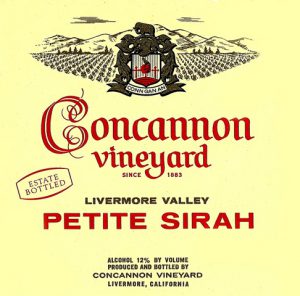
Beautiful Bunch of Petite Sirah
Petite Sirah is a mysterious grape with that originated in France in the 1880s but it undeniably reached its greatest heights and popularity in the USA. First, let’s understand that Petite Sirah and Syrah are completely different grapes. They are related, as we will discuss soon, but different. The name Petite Sirah was given by winegrowers as the grapes do resemble small Syrah grapes.
Petite Sirah is synonymous with Durif, the named for Dr. Francois Durif a botanist and grape breeder at the University of Montpellier. Dr. Durif found the grape in a field of Peloursin – a grape from the northern Rhone that is all but extinct at this stage. Peloursin is the mother of the Durif grape but when Dr. Durif discovered the new variety he did not know that the father (the pollinating grape) was Syrah.
Petite Sirah is grown around the world (where it it is primarily called Durif) being found in Mexico and South America, Australia, and Israel.
Petite Sirah/Durif was introduced into California by Charles McIver for use at his Linda Vista Vineyard in Alameda County. The grape soon found a growing following of wine growers. When phylloxera destroyed most all Syrah vines in California in the 1890s Petite Sirah really took off.
When Prohibition became the law of the land the wine landscape understandably changed in the United States. However, Petite Sirah held steady as it became a favorite with home winemakers in the eastern USA. The tougher skins and smaller berries made Petite Sirah a great grape to ship cross-country. While many wine grapes declined in acreage there was roughly 7,500 acres of Petite Sirah growing in California in the 1930s.
Petite Sirah’s peak acreage occurred in 1976 but by 1990 the number of acres had fallen to 1,400 – equal to plantings in Argentina at the time.

Concannon was an early Petite Sirah lover
Today there are roughly 10,000 acres of Petite Sirah planted in California with another 2,000 acres or so planted in the rest of the USA. I have been told that there are over 900 Petite Sirah wines commercially made in USA but many are produced in small quantities sold exclusively at tasting rooms or via wine clubs.
There certainly is a mostly quiet but extraordinarily loyal Petite Sirah fan base lurking in amongst the wine drinkers of America. There are also those who still find Petite Sirah to be an inferior grape producing nothing but simple and uninspiring wines but these poor souls are of course misguided and simply wrong.
Among the fans of Petite Sirah are a proud and loyal group of fans who have created a website to their favorite grape – PSILoveYou (Petite Sirah I Love You). I’m not kidding – check it out.
Fans appreciate the grape as Petite Sirah produces inky dark, purple colored wines that offer flavors of blackberries, blueberries, brown spice, and licorice. Petite Sirah is often added to other varietal wines in order to add color and spice. Often these vital contributions go with attribution. Petite Sirah is incredibly dense in color and fruit with very high levels of anthocyanin (an antioxidant). The wines have an incredible ability to age lasting two or three decades in the cellar while also being able to be enjoyed in their youth.
Petite Sirah may have been born in France but it is an American classic.

Thanks, Sean, for a BIG story on PETITE, and for the recognition. We appreciate your thoughtfulness and story of our beloved grape and its historical significance to the CA wine industry.
Thanks Jo. I’ve always had a big love for Petite Sirah.
Sean, great job on Petite. As you know Paso Robles has some outstanding examples of great Petite Sirah. Let me know next time you come to town, we can taste a bunch.
I agree. I will give a visit on my next visit to Paso.
L.A.Cetto winery in the Baja coastal section of Mexico produces a remarkable Petite Sirah winning Silver this year at Vinalies International in Paris France and the Petite Sirah Private reserve that has won many awards including Double Gold at S.F. International Wine Competition.
It would be great if L.A.Cetto submitted their wines for review. I’m sure our readers would love to learn about these Mexican wines.